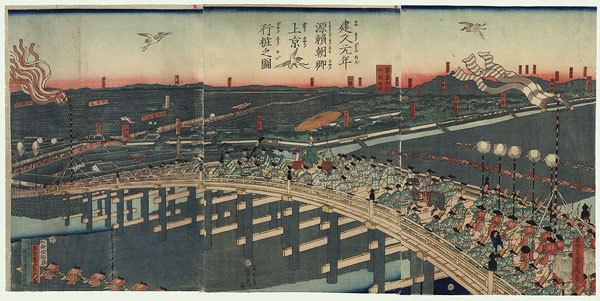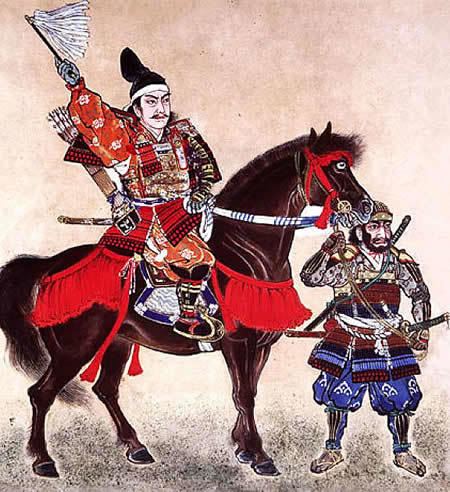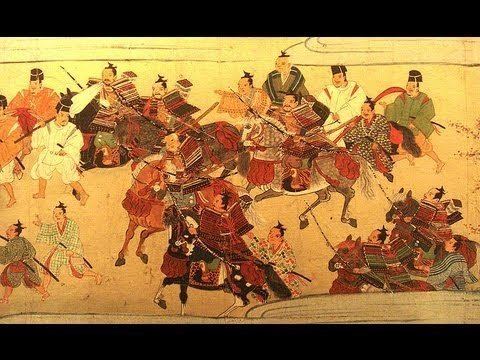Religion Shinbutsu-shūgō 1318–1339 Go-Daigo | Currency Ryō | |
 | ||
Government Feudal military dictatorship | ||
Kamakura shogunate
The Kamakura shogunate (Japanese: 鎌倉幕府, Kamakura bakufu) was a Japanese feudal military government that ruled from 1185 to 1333. The heads of the government were the shoguns. The first three were members of the Minamoto clan. The next two were members of the Fujiwara clan. The last six were minor Imperial princes.
Contents
- Kamakura shogunate
- Establishment
- The Hj Regency
- Mongol invasions
- Decline and fall
- Institutions
- List of Kamakura shoguns
- List of Kamakura shikken
- Genealogy
- References
These years are known as the Kamakura period. The period takes its name from the city where the Minamoto shoguns lived.

After 1203, the Hōjō clan held the office of shikken. In effect, the shikken governed in the name of the shoguns.

Kamakura shogunate
Establishment

Before the establishment of the Kamakura shogunate, civil power in Japan was primarily held by the ruling emperors and their regents, typically appointed from the ranks of the imperial court and the aristocratic clans that vied there. Military affairs were handled under the auspices of the civil government. However, after defeating the Taira clan in the Genpei War, Minamoto no Yoritomo seized super powers from the aristocracy. In 1192, Yoritomo and the Minamoto clan established a military government in Kamakura.
The Hōjō Regency
After Yoritomo's death, Hōjō Tokimasa, the clan chief of Yoritomo's widow, Hōjō Masako, and former guardian of Yoritomo, claimed the title of regent (Shikken) to Yoritomo's son Minamoto no Yoriie, eventually making that claim hereditary to the Hōjō clan. Eventually, Tokimasa deposed Yoriie; backed up his younger brother, Minamoto no Sanetomo, as a new shogun; and assumed the post of Shikken (regent). The Minamoto clan remained the titular shoguns, with the Hōjō holding the real power. In 1219, Sanetomo was assassinated by his nephew Kugyō. Since Sanetomo died childless, the line of shoguns from the Minamoto clan ended with him.
With the Regency, what was already an unusual situation became even more anomalous when the Hōjō usurped power from those who had usurped it from the Emperor in the first place. The new regime nonetheless proved to be stable enough to last a total of 135 years, 9 shoguns and 16 regents.
With Sanetomo's death in 1219, his mother Hōjō Masako became the Shogunate's real center of power. As long as she lived, regents and shoguns would come and go, while she stayed at the helm. Since the Hōjō family did not have the rank to nominate a shogun from among its members, Masako had to find a convenient puppet. The problem was solved choosing Kujo Yoritsune, a distant relation of the Minamoto, who would be the fourth shogun and figurehead, while Hōjō Yoshitoki would take care of day-to-day business. However powerless, future shoguns would always be chosen from either Fujiwara or imperial lineage to keep the bloodline pure and give legitimacy to the rule. This succession proceeded for more than a century.
In 1221 Emperor Go-Toba tried to regain power in what would be called the Jōkyū War (承久の乱, Jōkyū no Ran), but the attempt failed. The power of the Hōjō remained unchallenged until 1324, when Emperor Go-Daigo orchestrated a plot to overthrow them, but the plot was discovered almost immediately and foiled.
Mongol invasions
The Mongols under Kublai Khan attempted sea-borne invasions in 1274 and 1281. Fifty years before, the shogunate had agreed to Korean demands that the Wokou be dealt with to stop their raids, and this bit of good diplomacy had created a cooperative relationship between the two states, such that the Koreans, helpless with a Mongol occupation army garrisoning their country, had sent much intelligence information to Japan, so that along with messages from Japanese spies in the Korean peninsula, the shogunate had a good picture of the situation of the pending Mongol invasion. The shogunate had rejected Kublai's demands to submit with contempt. The Mongol landings of 1274 met with some success, but the Japanese had given the Mongols more casualties in an eight-hour engagement than they had had in fighting in China or Korea, and there was no rout of the Japanese defenders, who in any case greatly outnumbered the 40,000 combined invasion force of Mongols and Korean conscripts. Noting an impending storm, the Korean admirals advised the Mongols to re-embark so that the fleet could be protected away from shore; however, the typhoon was so destructive that one-third of the Mongol force was destroyed.
After the surviving forces returned to Mongol territory, Kublai was not dissuaded from his intentions on bringing Japan under Mongol control, and once again sent a message demanding submission, which infuriated the Hōjō leadership, who had the messengers executed. They responded with decisive action for defense — a wall was built to protect the hinterland of Hakata Bay, defensive posts were established, garrison lists were drawn up, regular manning of the home provinces was redirected to the western defenses, and ships were constructed to harass the invaders' fleet when they appeared.
The Mongols returned in 1281 with a force of some 50,000 Mongol-Korean-Chinese along with some 100,000 conscripts from the defeated Song empire in south China. This force embarked and fought the Japanese for some seven weeks at several locations in Kyushu, but the defenders held, and the Mongols made no strategic headway. Again, a typhoon approached, and the Koreans and Chinese re-embarked the combined Mongol invasion forces in an attempt to deal with the storm in the open sea. At least one-third of the Mongol force was destroyed, and perhaps half of the conscripted Song forces to the south over a two-day period of August 15–16. Thousands of invading troops were not able to embark in time and were slaughtered by the samurai. Such losses in men, material, and the exhaustion of the Korean state in provisioning the two invasions put an end to the Mongol's attempts to conquer Japan. The "divine wind," or kamikaze, was credited for saving Japan from foreign invasion.
For two further decades the Kamakura shogunate maintained a watch in case the Mongols attempted another invasion. However, the strain on the military and the financial expenditures weakened the regime considerably. Additionally, the defensive war left no gains to distribute to the warriors who had fought it, leading to discontent. Construction of defensive walls added further expenses to the strained regime.
Decline and fall
In 1331 Emperor Go-Daigo took arms against Kamakura, but was defeated by Kamakura's Ashikaga Takauji and exiled to Oki Island, in today's Shimane Prefecture. A warlord then went to the exiled emperor's rescue, and in response the Hōjō sent forces again commanded by Takauji to attack Kyoto. Once there, however, Takauji decided to switch sides and support Daigo. At the same time another warlord loyal to the emperor, Nitta Yoshisada, attacked Kamakura and took it. About 870 Hōjō samurai, including the last three Regents, committed suicide at their family temple, Tōshō-ji, whose ruins were found in today's Ōmachi.
In 1336, Ashikaga Takauji assumed the position of shogun himself, establishing the Ashikaga shogunate.
Institutions
The Kamakura shogunate functioned within the framework of the Heian system of Imperial rule.
Yoritomo established a chancellery, or mandokoro, as his principal organ of government. Later, under the Hōjō, a separate institution, the hyōjōshū became the focus of government.
The shogunate appointed new military governors (shugo) over the provinces. These were selected mostly from powerful families in the different provinces, or the title was bestowed upon a general and his family after a successful campaign. Although they managed their own affairs, in theory they were still obliged to the central government through their allegiance to the shogun. The military governors paralleled the existing system of governors and vice-governors (kokushi) appointed by the civil government in Kyoto.
Kamakura also appointed stewards, or jitō, to positions in the manors (shōen). These stewards received revenues from the manors in return for their military service. They served along with the holders of similar office, gesu, who delivered dues from the manor to the proprietor in Kyoto. Thus the dual governmental system reached to the manor level.
List of Kamakura shoguns
- Minamoto no Yoritomo, r. 1192–1199
- Minamoto no Yoriie, r. 1202–1203
- Minamoto no Sanetomo, r. 1203–1219
- Kujō Yoritsune, r. 1226–1244
- Kujō Yoritsugu, r. 1244–1252
- Prince Munetaka, r. 1252–1266
- Prince Koreyasu, r. 1266–1289
- Prince Hisaaki, r. 1289–1308
- Prince Morikuni, r. 1308–1333
List of Kamakura shikken
- Hōjō Tokimasa, r. 1203–1205
- Hōjō Yoshitoki, r. 1205–1224
- Hōjō Yasutoki, r. 1224–1242
- Hōjō Tsunetoki, r. 1242–1246
- Hōjō Tokiyori, r. 1246–1256
- Hōjō Tokimune, r. 1268–1284
- Hōjō Sadatoki, r. 1284–1301
- Hōjō Morotoki, r. 1301–1311
- Hōjō Takatoki, r. 1316–1326
Genealogy
This family tree illustrates the primary lines of descent and primary connections between the Kamakura shoguns and their successors. Numerous other family links existed as the various clans and cadet branches were heavily interrelated through marriage.
